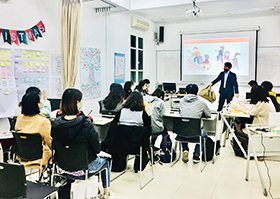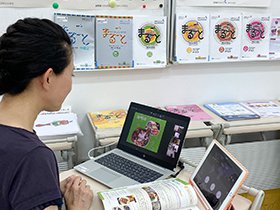Connecting People, Words, and Culture Even Amidst COVID-19
The Japan Foundation Center for Cultural Exchange in Vietnam
KATAGIRI Junji, ITO Aki, ENDO Kaori, TAKEDA Motoko, and ADACHI Kenji
2020 was the year in which COVID-19 spread throughout the world, and Vietnam has been praised as one of the most successful countries in controlling COVID-19 because of the appropriate and quick response by the government. Even so, due to multiple waves of community transmissions, in-person explanatory sessions and training programs have been cancelled, business trips have been cancelled or postponed, and, for events that were still held in-person, there were restriction on participants and measures to prevent the spread of COVID-19, such as temperature checks and wearing masks. Amidst these circumstances, we will introduce three of the projects carried out this year by the Japan Foundation Center for Cultural Exchange in Vietnam (hereinafter "JFVN").
Online Training Programs in Secondary Education
Training programs that are usually held in-person were reorganized into online trainings, and we then conducted them for Japanese-language teachers nationwide from October to December 2020. The first training, in October, was "Foreign-Language Education Goals" and dealt with goals for secondary school education based on Vietnam's Teaching and Learning Foreign Languages in the National Education System (Foreign Language Proficiency Framework) (Note); the second training, in November, was "Aims of Textbooks" and dealt with the composition/flow of textbooks, the purpose of various practice exercises, and their characteristics; and the third training, in December, was "Class Flow" and dealt with how to organize lessons using the various practice exercises in textbooks. The training method consisted of watching an explanatory video (approximately 30 to 40 minutes.) (Preliminary Task A), answering questions about the video's content and then submitting those answers (Preliminary Task B), and having discussions for 90 minutes between the participants at the session and commentary from the instructor. Compared to in-person trainings, the online trainings took more time to prepare for because of tasks such as creating video, but the participants gave us comments such as "The training was broad and concrete, and I was able to learn it from the theoretical content to putting it into practice," "I was able to review, compare, and confirm my current teaching style, and then I learned from other teachers' experience for my next lessons," and "I got good advice and ideas from the other participants, and I was able to exchange jokes with them." Through this, we found that not only was it possible to convey the content of the trainings online, but it was also possible to provide a place for the participants to learn from each other.
A Practical “Japanese Teacher Training Course"
As part of our special project to strengthen the development of Japanese-language teachers, since FY2018 we have been holding the "Japanese Teacher Training Course" for individuals who are aiming to become Japanese-language teachers and for individuals who have little experience as a practicing teacher, and from August 2020 to January 2021 we held this course for the fourth time. The course is a total of 200 hours, held every Saturday and Sunday, with 120 hours of the theory section on teaching methods to learn basic knowledge and then 80 hours of the practical course in which participants actually teach students. Here, we will talk a bit more in detail about the practical course in the latter half of the course.
The 19 students were divided into two teams, and each team was in charge of one class. Eleven N4 and N5 level Japanese-language learners, who were separately recruited as students, participated in each class. In the morning, the participants give a class to the students, and then in the afternoon, all the participants reflected on the class in the morning, and these sessions were held in JFVN classrooms while taking measures against the spread of COVID-19. Each team was scheduled to have two or three people in charge of each lesson. The teaching material that we used was "Irodori: Japanese for Life in Japan" (hereinafter "Irodori") Elementary 1, which is edited by the Japan Foundation, and this was the first time for all of the participants to use it while teaching. The "Irodori" confirms "Can-Do" goals and develops the lesson by using audio teaching materials, and this was particularly difficult for the participants who are currently teaching the Japanese language at schools because it was completely different from the way that they normally teach. The review in the afternoon was conducted entirely in the Japanese language, and was composed of review presentations by the participants who led classes, comments from participants on the same team who observed the lesson, and finally comments from JFVN Japanese-Language Specialists and from professors at Vietnam National University, Hanoi -- University of Languages and International Studies and Hanoi University, which co-sponsored the course. In particular, the comments from fellow participants were quite detailed, there were very active and lively discussions between the participants, and it seemed that everyone was having a good time.
All 19 participants completed the course without a single absence, and, in the final questionnaire, they provided comments such as "The course was fun and beneficial, and I learned a lot not only from the enthusiastic teachers, but also from the other participants," "I gained a lot of knowledge and skills, and I made friends," "I learned so much! However, I was stressed because all of my Saturdays and Sundays were gone (laughs)," so it seems that they were able to feel the joy of learning and making good friends while at the same time struggling with devoting all of their weekends.

Class by practical course participants
Starting “Marugoto: Ơi Sensei!”
For the JF Japanese-language courses in Hanoi, we are responsible for the work of connecting "people, language, and culture," just as is stated in the title of the teaching material "Marugoto". We try to listen to the voices of Japanese-language teachers and learners in the field while at the same time doing model Japanese-language classes, translating and publishing a Vietnamese-language version of the "Marugoto: Japanese Language and Culture" (hereinafter "Marugoto") series of teaching materials, holding explanatory sessions for people to learn about "Marugoto" and the JF Standard for Japanese-Language Education, holding hands-on courses for Japanese culture, and doing a variety of other tasks.
Based on opinions and comments from teachers who said things such as "I want to learn even more about 'Marugoto'!" and "I want to be able to teach more effectively," in September 2020, we launched the new “Marugoto: Ơi Sensei!” (Online Pilot Course) for the Pre-Intermediate edition (hereinafter “Marugoto: Ơi Sensei!”). We continually improved this first course for a month and a half, and then, from February to May 2021, we implemented the second version of the course.
In this course, in addition to using the "Marugoto" Pre-Intermediate (A2/B1) and learning the Japanese language, participants learn the knowledge and techniques that are necessary for teaching via lectures and discussions with colleagues. It is a practical course where participants improve their Japanese-language abilities while also learning to effectively teach the "Marugoto" in a way that complies with the JF Standard for Japanese-Language Education, and, at the end of the course, there is also an online mock lesson in which the participants themselves become the teachers.
We decided to start the course online because we wanted to target Japanese-language teachers all over Vietnam. Both the first and second courses had twice as many applicants as there were openings, and there were also applications from outside Vietnam, which shows that quite a few people are interested in this course.
The participants of course included individuals teaching at universities, Japanese-language schools, and institutions that send out students, but also included students majoring in the Japanese language and who want to become Japanese-language teachers in the future. Additionally, there were teachers in Vietnam who teach the Japanese language online to Vietnamese people who are staying in Japan and experienced teachers who are working in Japan but who want to be Japanese-language teachers when they return to Vietnam. The backgrounds of the participants varied, but they all had the same passion for of "I want to become a better Japanese-language teacher and I want to hold better classes!"
The "Ơi" ("Oi") in "' Marugoto: Ơi Sensei!" is from the Vietnamese-language word used to call out to someone and get their attention. Similarly, we want to actively talk to Japanese-language teachers in their schools and to always carry out activities nearer to teachers that work with a positive attitude.

During a “Marugoto: Ơi Sensei!”
Note: In Vietnamese, is the "Khung Năng Lực Ngoại Ngữ (KNLNN)." It has divisions that are close to the A1 to C2 divisions in the Common European Framework of Reference for Languages (CEFR) and the JF Standard for Japanese-Language Education, and the goals for each level are described in six stages, from one to six, in order from the starter level. Levels one and two are the target of this secondary educational training.
- What We Do Top
- Arts and Cultural Exchange [Culture]
- Japanese-Language Education Overseas [Language]
- Japanese-Language Education Overseas [Language] Top
- Learn Japanese-language
- Teach Japanese-language
- Take Japanese-Language Test
- Know about Japanese-language education abroad
- The Japanese-Language Institute, Urawa
- The Japanese-Language Institute, Kansai
- Japanese-Language Programs for Foreign Specified Skilled Worker Candidates
- Japanese Language Education for Japanese Children Resident Overseas and for the Descendants of Migrants
- Archives
- Japanese Studies and Global Partnerships [Dialogue]
- JF digital collection
- Other Programs / Programs to Commemorate Exchange Year
- Awards and Prizes
- Publications
